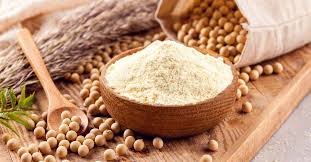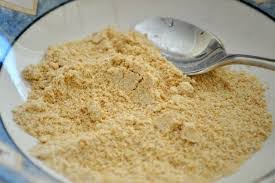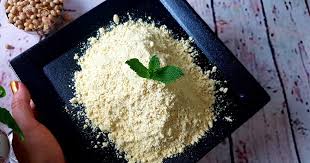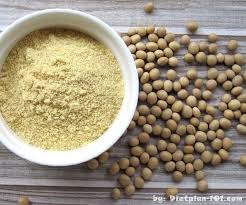Soya beans powder and soy flour are both derived from soybeans and are commonly used in various culinary applications and food products. However, despite their similar origins, they differ in terms of processing, nutritional content, and culinary uses.
Understanding these differences is essential for consumers, cooks, and food manufacturers looking to optimize their recipes or dietary choices.
Soya beans powder is made by grinding whole roasted soybeans into a fine powder. This process retains most of the nutrients found in the whole bean, including proteins, fats, vitamins, and minerals.
The result is a product that is high in protein and has a slightly nutty flavor, making it suitable for various uses, including smoothies, protein shakes, baking, and even as a thickening agent in soups and sauces.
Soya beans powder is often favored by those seeking a plant-based protein source, as it is rich in essential amino acids and contains healthy fats.
On the other hand, soy flour is produced by grinding defatted soybeans, which means that most of the oil has been removed during processing. This results in a lower fat content compared to soya beans powder. Soy flour is available in two forms: natural and roasted.
Natural soy flour is made from raw soybeans, while roasted soy flour is made from roasted soybeans, giving it a more pronounced flavor. The roasting process enhances the flavor and aroma, making it a popular choice for baking and cooking.
Soy flour is often used as a protein supplement in various products, including bread, pasta, and protein bars, due to its ability to improve texture and increase nutritional value.
In terms of nutritional content, soya beans powder generally has a higher fat content due to the presence of healthy oils. It is rich in polyunsaturated fatty acids, which are beneficial for heart health.
The higher fat content also contributes to a creamier texture in recipes, making it an excellent choice for creamy sauces and dressings. In contrast, soy flour has a lower fat content, which can be advantageous for those looking to reduce their calorie intake or fat consumption.
However, soy flour still provides a substantial amount of protein, making it a valuable ingredient for health-conscious consumers.
When it comes to culinary applications, both soya beans powder and soy flour have their unique uses. Soya beans powder can be used in smoothies, as a protein boost in baked goods, or as a thickener in soups and gravies. Its nutty flavor complements many dishes, enhancing their overall taste and nutritional value.
Soy flour, with its slightly different texture and flavor, is commonly used in baking, especially in gluten-free recipes. It can help improve the structure and moisture of baked goods while adding a protein boost.
While soya beans powder and soy flour share a common origin, they have distinct differences that make them suitable for different applications. Soya beans powder retains the whole soybean’s nutrients and healthy fats, making it ideal for smoothies and creamy dishes.
In contrast, soy flour, with its lower fat content, is better suited for baking and improving the nutritional profile of various food products.
Understanding these differences allows consumers and food manufacturers to choose the appropriate ingredient for their needs, enhancing both flavor and nutrition in their culinary creations.
Composition of Soya Beans Powder and Soy Flour

1. Protein Content: Both soya beans powder and soy flour are rich in protein, with soy flour typically containing about 40-50% protein, while soya beans powder has around 36-40%.
2. Fat Content: Soya beans powder contains approximately 20% fat, primarily healthy unsaturated fats, whereas soy flour has a slightly lower fat content of about 18%.
3. Carbohydrates: Soya beans powder has around 30% carbohydrates, mainly in the form of fiber, while soy flour has about 30-35% carbohydrates, including both fiber and starch.
4. Fiber: Both products are high in dietary fiber, aiding digestion; soya beans powder typically has more fiber due to less processing.
5. Vitamins and Minerals: Both contain essential vitamins and minerals such as B vitamins (B1, B2, B6, folate) and minerals like iron, calcium, magnesium, and potassium, which contribute to overall health.
Nutritional Value Comparison
1. Caloric Content: Soya beans powder has about 350-400 calories per 100 grams, while soy flour contains slightly fewer calories, around 350-360 per 100 grams.
2. Amino Acid Profile: Both have a complete amino acid profile, but soya beans powder may provide slightly higher levels of certain amino acids due to less processing.
3. Antioxidants: Soya beans powder generally retains more antioxidants, such as isoflavones, compared to soy flour, which may lose some during processing.
4. Glycemic Index: Both products have a low glycemic index, making them suitable for managing blood sugar levels; however, soy flour may have a slightly higher index due to its processing.
5. Uses: Soya beans powder is often used as a protein supplement in shakes and smoothies, while soy flour is commonly used in baking and as a thickening agent.
Processing Methods of Soya Beans Powder and Soy Flour
1. Cleaning: The processing of soya beans begins with thorough cleaning. This step is crucial to remove any impurities, such as dirt, stones, broken beans, or other foreign materials that might have been collected during harvesting and storage. Clean beans ensure the final product’s quality and safety for consumption. Industrial cleaning machines often use air blowing and screening methods to effectively remove contaminants.
2. Soaking: After cleaning, the soya beans are soaked in water for several hours, typically 8 to 12 hours. This hydration process is essential for several reasons. First, soaking softens the beans, making them easier to process. Second, it activates enzymes that improve the nutritional profile by breaking down anti-nutritional factors like oligosaccharides, which can cause digestive issues. Soaking also enhances the flavor and texture of the final products.
3. Cooking: Once soaked, the beans are cooked to further soften them. Cooking involves boiling the soaked beans in water for about 30 to 60 minutes. This step not only makes the beans tender but also deactivates certain anti-nutritional factors, such as trypsin inhibitors and phytates, which can interfere with protein digestion and mineral absorption. Cooking also enhances the flavor and digestibility of the beans, making them more palatable.
4. Drying: After cooking, the beans are dried to reduce their moisture content to a safe level for grinding. The drying process typically involves using industrial dehydrators or ovens set at low temperatures. This step is crucial because excess moisture can lead to spoilage and reduce the shelf life of the final product. Properly dried beans are easier to grind and store, resulting in a more stable product.
5. Grinding: The dried beans are then ground into a fine powder or flour. This grinding process is done using industrial grinders, which can efficiently produce a consistent particle size. For soya beans powder, the grinding is usually more refined, resulting in a smooth texture, while soy flour may retain a slightly coarser consistency, depending on the specific grinding technique used.
6. Sieving: After grinding, the powder is sieved to ensure uniformity in particle size. This sieving process is essential for quality control, as it helps to remove any larger particles or impurities that may have escaped the grinding phase. The goal is to achieve a fine, homogenous powder that meets the desired specifications for various culinary applications.
7. Packaging: Finally, the processed soya beans powder or soy flour is packaged in airtight containers. Proper packaging is vital to preserving the product’s freshness, flavor, and nutritional value while preventing moisture and contamination. Many manufacturers use vacuum-sealed bags or cans with oxygen absorbers to enhance shelf life. The labeling also includes important information regarding usage, nutritional content, and storage instructions.
Read Also: 16 Medicinal Health Benefits Of Echinopsis peruviana (Peruvian Torch Cactus)
Culinary Uses of Soya Beans Powder

1. Smoothies: Soya beans powder is an excellent addition to smoothies, providing a rich source of plant-based protein. It can enhance the flavor and nutritional profile of various smoothie recipes, making them more filling and satisfying. The powder blends well with fruits, vegetables, and liquids, creating a creamy texture without overpowering other flavors.
2. Baking: In the baking industry, soya beans powder is commonly used to increase the protein content of bread, muffins, cookies, and cakes. Its neutral flavor allows it to complement sweet and savory baked goods. When incorporated into recipes, soya beans powder can help retain moisture, resulting in a softer crumb and extended shelf life for baked products.
3. Soups and Sauces: Soya beans powder can be used as a thickening agent in soups and sauces, providing a creamy texture without the need for dairy. When added to broth or sauce, the powder dissolves and thickens the mixture, enhancing the mouthfeel and nutritional value. It can also be used to create hearty, plant-based soups, catering to vegetarian and vegan diets.
4. Protein Shakes: As a rich source of protein, soya beans powder is an ideal ingredient for protein shakes. Whether for post-workout recovery or meal replacement, adding this powder increases the shake’s nutritional content while offering a smooth texture. Blending soya beans powder with fruits, nut milks, or yogurt creates a delicious and nutritious beverage.
5. Meat Alternatives: Soya beans powder plays a crucial role in developing plant-based meat alternatives. It enhances the protein levels of products like veggie burgers, sausages, and meatless meatballs while providing a texture that mimics meat. The powder can be blended with various ingredients, such as vegetables and spices, to create flavorful, meat-like products.
Culinary Uses of Soy Flour
1. Baked Goods: Soy flour is often utilized in baking to improve the nutritional profile of pancakes, waffles, muffins, and cookies. The addition of soy flour not only increases protein content but also enhances moisture retention, contributing to a softer texture in baked goods. Its slightly nutty flavor can also add depth to the taste of various recipes.
2. Pasta and Noodles: In pasta-making, soy flour is commonly incorporated into recipes to boost nutritional value. When mixed with wheat flour, it can enhance the protein content while providing a unique texture and flavor to the noodles. This combination is particularly beneficial for those seeking higher protein intake without compromising taste.
3. Sauces and Dressings: Soy flour can act as a thickening agent in sauces and dressings. When added to liquid mixtures, it absorbs moisture and swells, creating a creamy consistency. This property makes it ideal for gravies, salad dressings, and dips, allowing for healthier alternatives that are rich in protein.
4. Breakfast Foods: Many breakfast cereals and protein bars include soy flour for its nutritional benefits. Its addition not only enhances the protein content but also contributes to a satisfying mouthfeel and flavor. This versatility makes soy flour a popular choice in various breakfast products, catering to health-conscious consumers.
5. Gluten-Free Baking: Soy flour is a valuable ingredient in gluten-free baking. It provides structure and moisture to recipes, helping achieve a desirable texture in bread and baked goods that often lack gluten. Its unique properties enable bakers to create gluten-free products that are enjoyable to eat without sacrificing flavor or texture.
Texture and Flavor Differences
1. Texture: One of the most noticeable differences between soya beans powder and soy flour lies in their texture. Soya beans powder is typically finer and smoother, which makes it suitable for applications where a silky finish is desired, such as in smoothies or creamy sauces. In contrast, soy flour may have a slightly coarser consistency, which can contribute to a more rustic texture in baked goods.
2. Flavor Profile: The flavor profiles of these two products also differ. Soya beans powder usually has a more neutral taste, allowing it to blend seamlessly into various recipes without altering the flavor significantly. On the other hand, soy flour tends to have a nuttier taste, which can enhance the overall flavor of baked goods and other dishes, giving them a richer, more complex profile.
3. Binding Properties: In culinary applications, soy flour has superior binding properties compared to soya beans powder. This quality makes soy flour particularly effective in recipes requiring structure, such as baked goods and meat alternatives. Conversely, soya beans powder works well for thickening soups and sauces, where binding is less critical.
4. Usage in Recipes: Due to its finer texture, soya beans powder is often preferred in recipes where a smooth, creamy finish is desired. It’s ideal for smoothies, sauces, and soups. In contrast, soy flour is favored in recipes that benefit from its nutty flavor and binding properties, such as baked goods and plant-based meat products.
5. Nutritional Impact: While both soya beans powder and soy flour are nutritious, the specific applications may vary based on their textural properties and flavor profiles. Soya beans powder is rich in protein, fiber, and essential fatty acids, while soy flour also provides additional nutrients, such as vitamins and minerals, making both valuable additions to a balanced diet.
Read Also: Worm Infestation on Ruminant Animals: Symptoms and Treatment
Health Benefits of Soya Beans Powder

1. High Protein Content: Soya beans powder is an excellent source of plant-based protein, containing all essential amino acids. This makes it an ideal choice for vegetarians and vegans seeking to meet their protein needs. The protein content supports muscle growth, repair, and overall body function.
2. Heart Health: Regular consumption of soya beans powder may help lower cholesterol levels. The presence of polyunsaturated fats, particularly omega-3 and omega-6 fatty acids, contributes to heart health by reducing LDL (bad) cholesterol while promoting HDL (good) cholesterol levels. This balance can decrease the risk of heart disease.
3. Bone Health: Soya beans powder contains calcium, magnesium, and phosphorus, essential nutrients for maintaining strong bones. Regular intake can contribute to bone density and may reduce the risk of osteoporosis, particularly in postmenopausal women.
4. Hormonal Balance: Soya beans powder is rich in phytoestrogens, particularly isoflavones, which can mimic estrogen in the body. This property may help alleviate menopausal symptoms, such as hot flashes and mood swings, by promoting hormonal balance.
5. Weight Management: The high protein and fiber content in soya beans powder can promote satiety, helping individuals feel full longer. This can be beneficial for those looking to manage their weight, as it may reduce overall calorie intake by curbing cravings.
6. Antioxidant Properties: Soya beans powder is rich in antioxidants, which help neutralize free radicals in the body. This can reduce oxidative stress and inflammation, potentially lowering the risk of chronic diseases, including cancer.
7. Digestive Health: The fiber content in soya beans powder supports healthy digestion by promoting regular bowel movements and preventing constipation. Additionally, soluble fiber can aid in maintaining healthy gut flora.
Health Benefits of Soy Flour
1. Nutrient-Rich: Soy flour is packed with essential nutrients, including protein, healthy fats, vitamins (like B vitamins), and minerals (like iron and calcium). These nutrients contribute to overall health and well-being, supporting various bodily functions.
2. Blood Sugar Control: The low glycemic index of soy flour makes it a suitable option for individuals with diabetes. It can help regulate blood sugar levels and may reduce the risk of insulin resistance due to its fiber and protein content.
3. Cardiovascular Health: Similar to soya beans powder, soy flour may help lower cholesterol levels, supporting heart health. Its high fiber content can also improve heart health by aiding in weight management and reducing the risk of heart disease.
4. Supports Weight Loss: Soy flour can enhance feelings of fullness due to its protein and fiber content, making it beneficial for weight management. Incorporating soy flour into meals can help control hunger and prevent overeating.
5. Hormonal Balance: Like soya beans powder, soy flour contains phytoestrogens that can positively impact hormonal balance, particularly in women. This may alleviate symptoms associated with menopause and support overall reproductive health.
6. Enhanced Digestive Health: The fiber in soy flour aids in digestion by promoting regular bowel movements and improving gut health. It can also contribute to the prevention of gastrointestinal issues.
Applications in Baking and Cooking
1. Baking: Both soya beans powder and soy flour are popular ingredients in baking. They can be added to recipes for bread, muffins, pancakes, and cookies to increase protein content and enhance nutritional value. Soya beans powder generally provides a smoother texture, while soy flour adds a nuttier flavor.
2. Thickening Agent: Soya beans powder is often used as a thickening agent in soups, sauces, and gravies. It can dissolve easily in liquid, providing a creamy texture and increasing the nutritional content of the dish.
3. Meat Alternatives: Soy flour is commonly used in the production of plant-based meat alternatives. It can be combined with other ingredients to create veggie burgers, sausages, and meatballs, offering a protein-rich and satisfying option for vegetarians and vegans.
4. Protein Shakes and Smoothies: Soya beans powder is a popular ingredient in protein shakes and smoothies, providing a quick and convenient way to boost protein intake. It blends well with fruits, vegetables, and liquids, creating a nutritious beverage.
5. Breakfast Foods: Both soya beans powder and soy flour can be used in breakfast foods like oatmeal, cereals, and protein bars. They enhance the nutritional profile, making these meals more satisfying and healthful.
6. Pancakes and Waffles: Soya beans powder and soy flour can be incorporated into pancake and waffle batters to improve the protein content and add flavor. They create fluffy and filling breakfast options.
Shelf Life and Storage
1. Shelf Life: The shelf life of soya beans powder and soy flour varies depending on storage conditions. Typically, both products can last between 6 months to 1 year when stored properly. Always check the expiration date on the packaging for guidance.
2. Storage Conditions: To maximize shelf life, store soya beans powder and soy flour in a cool, dry place away from direct sunlight. An airtight container is recommended to prevent moisture absorption, which can lead to spoilage and a decline in quality.
3. Refrigeration: If you live in a warm and humid climate, consider refrigerating or freezing the powder or flour to extend its shelf life. Make sure to use airtight containers to prevent moisture and odors from affecting the product.
4. Signs of Spoilage: Always check for signs of spoilage before use. Look for changes in color, texture, or smell. If the powder or flour has an off odor, unusual clumping, or an altered appearance, it’s best to discard it.
5. Usage Tips: For best results, use the products within the recommended time frame. Consider labeling containers with the purchase date to keep track of freshness. When using older stock, smell and taste a small amount to ensure quality before adding it to recipes.
Do you have any questions, suggestions, or contributions? If so, please feel free to use the comment box below to share your thoughts. We also encourage you to kindly share this information with others who might benefit from it. Since we can’t reach everyone at once, we truly appreciate your help in spreading the word. Thank you so much for your support and for sharing!
Read Also: The Different Types of Fertilizers and How they Work






